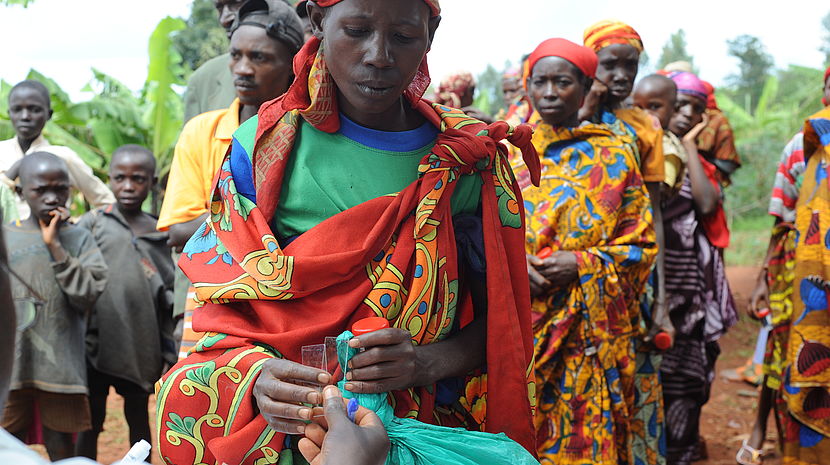Addressing mental health and stigma in Neglected Tropical Diseases

Women taking part in the schistosomiasis survey, part of a Neglected Tropical Diseases programme in Burundi.
© CBM
This article addresses cross-cutting issues in NTDs including stigma, discrimination, and mental health - to raise the profile of the links between these two neglected fields.
Neglected tropical diseases (NTDs) are a group of mainly infectious diseases that affect people in many of the poorest parts of the world. They include onchocerciasis (river blindness), schistosomiasis (bilharzia), trypanosomiasis (sleeping sickness), trachoma, worms, and many others. Between them, they are the cause of a huge amount of disability, but have historically been sidelined. CBM has worked for many decades to reduce their prevalence and their negative impacts, particularly those that cause blindness.
Despite their collective name, in recent years, they have started to receive increased attention. The London Declaration on NTDs in 2012 lays out an ambitious agenda to eradicate many of these conditions, which has led to a great deal of collaboration and coordinated action by a consortium of actors.
The major focus of the London Declaration is the reduction of prevalence, and in many cases, eradication, of many of these diseases. Its regularly updated dashboard shows that in the last 2 years 1 billion people have received treatment, and in 24 countries, at least one NTD has been eradicated.
While the attention and allocation of resources to combat these debilitating diseases is welcome, unfortunately, less attention has been paid to addressing the needs of the people already affected by these conditions. In addition to the physical suffering and disability associated with NTDs, affected people often face social exclusion and have high rates of mental ill health.
How are NTDs, stigma and mental health connected?
There are several links between NTDs and poor mental health:
- Some disease processes directly affect the brain in ways that lead to mental and neurological consequences;
- Chronic pain, reduced function, and discomfort are associated with increased rates of depression;
- The stigma that many people with NTDs experience as a consequence of disability, disfigurement or misconceptions about their illness appears to be a very important mediator to mental illness.
Mental illness and stigma sets in train a process leading to disadvantages in many aspects of life, reducing social participation and treatment benefit, and increasing disability.
Stigmatising attitudes are often internalised by those affected, leading to feelings of shame and low self-esteem, which – along with social restrictions – cause mental distress and increase the likelihood of depression, anxiety and other mental disorders. Poor mental health, shame and stigma reduce self-efficacy and act as a barrier to help-seeking and treatment adherence. All these factors adversely influence effectiveness of treatments leading to poor recovery rates and maintaining disability levels and visibility of the illness, thereby further reinforcing negative attitudes and discrimination.
In addition to the direct effects of societal stigma, persons suffering from NTDs face several forms of structural stigma, manifest, for example, in the lack of resources allocated to this neglected group and low training levels and negative attitudes amongst health care staff. This in turn affects the availability, quality and uptake of treatments offered, feeding back in to the cycle of poor treatment outcomes, persistent stigma and poor mental health.
What can we do to combat mental health problems?
Recognising the links between NTDs and mental health is important, to ensure that health programmes adequately meet the needs of those affected, to improve outcomes for beneficiaries and programmes, and to ensure that mental health services receive the resources they deserve for comprehensive approaches to be delivered. It has been shown that if depressive illness is taken into account, the amount of measured disability associated with lymphatic filariasis doubles.
Available evidence suggests that the most effective way to combat stigma are interventions which empower people affected to take a key role in engaging with communities to change attitudes. Evidence-based strategies for promotion of mental health, and stigma reduction include:
- Governments: improve access to mental health care in mainstream health services; link NTD and mental health services
- NTD programmes: improve knowledge about mental health and stigma among staff; promote peer support by people affected; challenge negative community attitudes
- Funders and NGOs: include mental health and stigma reduction as an integral part of investment in programming, recognising the importance of well-being as a priority for service users, and for improving outcomes.
New manual for mental health implementation
Since 2017, a consortium of organisations working in this area has formed a Task Group on Mental Wellbeing and Stigma, under the umbrella of the NTD NGO Network (NNN). Several key pieces of research have been published based on work in CBM partner programmes. In 2018, a group led by CBM, Lepra and Brighton and Sussex Medical School, started working with the World Health Organisation to develop a manual for implementers and governments to carry out effective mental health work as an integral part of their NTD programmes. This is expected to be ready by the end of 2019, and to guide practical support for people doubly disabled by both NTDs and negative mental health impacts.
More reading
Know more about NTDs and how CBM combats them.
Have a look at our NTD Report 2017.
Read more about combating stigma and mental health in NTDs.